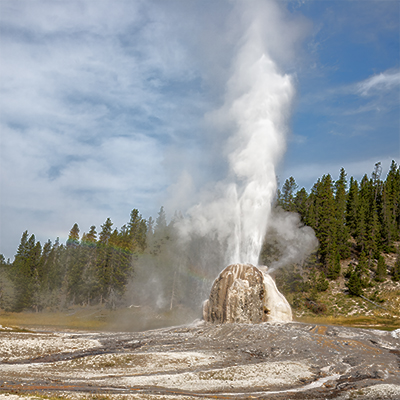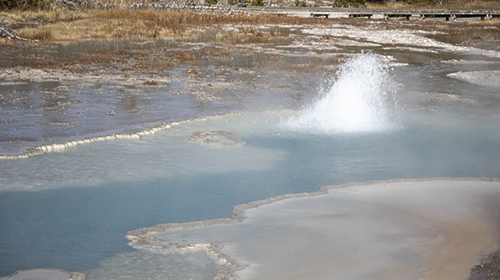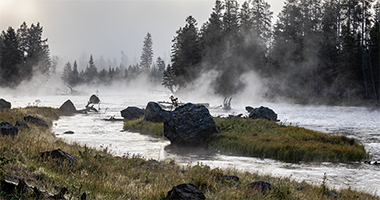What is a Geyser Basin?

A basin is a cluster of hydrothermal features in a specific area. Those areas are often, but only sometimes, in low-lying areas because hydrothermal features are usually concentrated around margins of lava flows and areas of faults.
The main, easily accessible basins in Yellowstone are listed in alphabetical order as follows:

Gibbon Geyser Basin
Located between Madison Junction and Norris Geyser Basin. Gibbon Geyser Basin has many accessible features, including:
- Artist Paintpots, 1 mile (1.6 km) trail. At this point, you can go right or left, go right. That takes you up the hill, and the rest is downhill.
- Beryl Springs, by the roadside.
- Monument Geyser Basin, 2.4 miles there and back trail. The 600-foot elevation gain in 0.6 miles.
- The Chocolate Pots, by the roadside.
Artist Paintpots is a colorful area where few features are named. The two mud pots are at the top of the hill and are my favorite. They are separated by a dirt wall. They typically have different amounts of fluid, causing them to behave differently. The west one is generally dryer, so the action is noisier and can spit mud up to 20 feet away. The east pool is soupier and is more like watching a pan of water boiling.
Lone Star Geyser Basin
Locate the parking for the trailhead at the east end of Keplar Cascade parking. It is a 4.8-mile round trip hike on an old service road through the woods beside Firehole River. It is a peaceful and pleasant walk. Bikes are allowed. The broken road surface can be bumpy. Please pay attention to the road surface and walkers.
Lone Star Geyser is 2.4 miles from the trailhead, marking the usual turn-around point for this hike.
Lone Star Geyser erupts every three hours. Visitors often ask if it is monitored and if the rangers can tell them when the next eruption is. The short answer is no.
At Lone Star Geyser, there is a podium containing a logbook. NPS encourages people to document the date and time they see an eruption in the logbook so that others can tell when the geyser last erupted. Recording in the logbook is another way to be a citizen scientist because the park will use that data.


Lower Geyser Basin
The lower Geyser Basin is five square miles of widely scattered features. Two of the largest, easily accessible areas are Fountain Paintpots and Firehole Lake Drive. Fountain Paintpots contains one of Yellowstone's largest assortments of mudpots. Firehole Lake Drive contains Great Fountain Geyser, White Dome Geyser, Pink Cone Geyser (see picture below), hots springs, and Black Warrior Lake.
Fountain Paintpots is home of a large pink mudpot, Silex Pool, Celestine Pool, Clepsydra Geyser, and Fountain Geyser.
Fountain Paintpots is mainly flat, but there are stairs going from the mudpots down to Clepsydra and Fountain Geyser. You have access to all the area, but you will have to backtrack to the Celestine Pool intersection twice. (See below for an accessibility note.)1
Midway Geyser Basin
Midway Geyser Basin is home to the world-renowned Grand Prismatic Spring. Grand Prismatic is the largest hot spring in Yellowstone and the third largest in the world. It is over 121 feet (37 m) deep and has an approximate diameter of 370 feet (112.8 meters). As of 2016, people can now get a high view of this beautiful hot spring. Access the Overlook from the Fairy Falls parking lot, walking 3/4 of a mile from the bridge. Take the prescribed path up the hill on the left side of the trail.
Also in Midway Geyser Basin is the crater of Excelsior Geyser. The crate-creating eruptions occurred in the late 1800s. (See image to the right.)
The path to this basin takes you over the Firehole River near the runoff from Excelsior Geyser. The boardwalk is a switchback up the hill. Once up the hill, the boardwalk is level. I have seen motorized wheelchairs easily navigate the incline. Using manual wheelchairs will depend on the operator's ability.
The view at Midway Geyser Basin gives you a ground-level, close-up look at the beautiful bacteria mats. The Overlook will provide you with a more sweeping aerial view. The overlook trail is flat. The hill isn't. Based on your health (bad knees/hips, respiratory or heart problems), going up the trail a short way may be enough to get a better view.


Norris Geyser Basin
Norris Geyser Basin is located at the Norris-Canyon junction on the Grand Loop Road. The 2.25 miles (3.6 km) of earth and boardwalk trails are divided into Back Basin and Porcelain Basin.
Norris Geyser Basin is the home of Steamboat Geyser, the tallest active geyser in the world. Steamboat's intervals can be five days to 50 years. But on March 15, 2018, Steamboat started a very active period of erupting a few days apart. It had only 8 eruptions in 2023. When will it go into another dormant period? Standby, I will get back to you on that.
Norris is a very different type of basin. Most of the features in the other basins are alkaline, whereas Norris's features are primarily acidic. Many of these features are more acidic than battery acid. Norris is the third largest geyser basin in Yellowstone in size and number of geysers.
Because of the acidity, features in Norris have a different look, and other bacteria grow in the area. This gives you a variation of colors. Most of the pools have a milky appearance due to the suspended particles in the water.
Upper Geyser Basin
The Upper Geyser Basin comprises the Old Faithful area, Biscuit Basin, and Black Sand Basin.
The Old Faithful area is the home of 5 predictable geysers: Old Faithful, Castle, Grand, Daisy, and Riverside. Grand is the tallest predicted geyser in the world. Three geysers erupt during a Grand eruption. Check the Basin menu above to read about other geysers or basins featured on this site.
The Upper Geyser Basin has the largest collection of geysers in the world, 150 in a 1 square mile area. Geyser Hill, across the river from Old Faithful, is the home of 50 of those 150 geysers.
Annually, 90% of visitors to Yellowstone come to the Upper Geyser Basin to see Old Faithful Geyser and the general area. One "must-do" in the Upper Geyser Basin is stepping into the Old Faithful Inn. This beautiful building, built the same year the Wright Brothers did the first power flight, is just a super wow experience.
Be aware that bison are in this area all of the time. Please keep yourself and your family safe by staying 25 yards or more from these huge wild animals. What is the saying? "look, but don't touch."


West Thumb
While a smaller basin with fewer geysers, this basin sits on the edge of Yellowstone Lake. If you are into sunrise pictures, this is a great spot, as shown in the photo to the left.
There are some inclines, but they are mostly straightforward. Just take it slowly as dictated by your body.
You may see elk about, especially in the fall. Please, like with bison, keep your distance. The trees are also an excellent place to look for birds you may not see in your home area. I have almost always seen a Snowshoe Hare when I visit this basin. Look for the ephydrid flies on the hot water. Yes, on the hot water. They mate in the hot spring, and their larva eats the bacteria. They are, in turn, eaten by spiders that inhabit the hot water. The flies can live on water up to 109°F (43°C).
You can access Heart Lake Geyser Basin and Shoshone Geyser Basin with more hiking. Other basins are off-trail, and many are off-limits, so they will not be discussed here.
Mammoth Hot Springs is another accessible area where you can see the amazing geothermal sights of Yellowstone. At Mammoth, the geology is different. Underground is limestone that the water comes up through. The water deposits calcium carbonate that forms travertine, creating the beautiful terraces you will see.
Use the top menu, sitemap, or side menus, when available, to navigate to the available basin pages.

1If you have accessibility issues, please ask at a Visitor Center desk or entrance gate for the Accessibility Guide.















